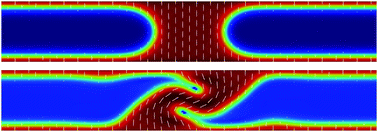Active nematic–isotropic interfaces in channels†
Abstract
We use numerical simulations to investigate the hydrodynamic behavior of the interface between nematic (N) and isotropic (I) phases of a confined active liquid crystal. At low activities, a stable interface with constant shape and velocity is observed separating the two phases. For nematics in homeotropic channels, the velocity of the interface at the NI transition increases from zero (i) linearly with the activity for contractile systems and (ii) quadratically for extensile ones. Interestingly, the nematic phase expands for contractile systems while it contracts for extensile ones, as a result of the active forces at the interface. Since both activity and temperature affect the stability of the nematic, for active nematics in the stable regime the temperature can be tuned to observe static interfaces, providing an operational definition for the coexistence of active nematic and isotropic phases. At higher activities, beyond the stable regime, an interfacial instability is observed for extensile nematics. In this regime defects are nucleated at the interface and move away from it. The dynamics of these defects is regular and persists asymptotically for a finite range of activities. We used an improved hybrid model of finite differences and the lattice Boltzmann method with a multi-relaxation-time collision operator, the accuracy of which allowed us to characterize the dynamics of the distinct interfacial regimes.



 Please wait while we load your content...
Please wait while we load your content...